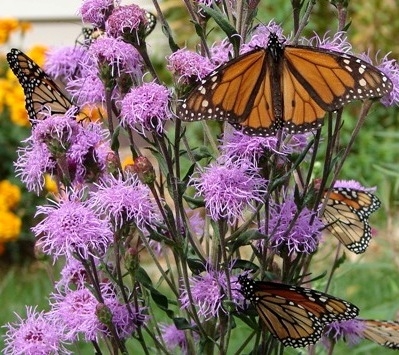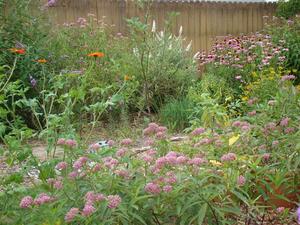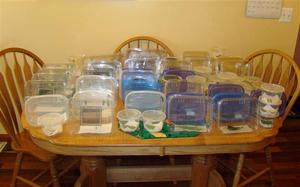Want to attract butterflies to your garden? Meet Brenda Dziedzic

A monarch butterfly gathering nectar from Rough Blazing Star (Liatris aspera)
Photo by Brenda Dziedzic
When you need some good advice on enticing butterflies to your garden, you call an electronic engineering technician, right? It’s the natural choice.
Well, in this case that would be the exactly right thing to do, because Brenda Dziedzic is both a retired electronics technician, and a self-taught expert on attracting and raising butterflies. While she’s always had a love of nature, she learned about butterflies through research, hands-on training, and a nudge in the right direction from another butterfly aficionado.
Let’s learn about her, and some lessons you can learn to increase the life around your garden.
As mentioned above, Brenda was an electronic engineering technician at AT&T, but in 2001 she wanted to see butterflies like she used to when she was a kid. As this area has become increasingly developed, the fields and woods that supported a healthy butterfly and moth population have largely been lost to commercial developments, housing developments and roads, which take up lots of good growing area and replace them with fast-moving, butterfly-mashing cars.
Brenda wanted to see what she could do to increase the number of butterflies and moths, at least in her yard.
One day, early in her research, she ran into Lois Hansen at a local Frank’s Nursery, and told her of her interest. She showed Lois a list of plants she had put together that she thought she would use to attract butterflies to her yard, and Lois crossed out almost every one as a bad choice.
Following this shocking act, she recommended that Brenda study catalogs from Prairie Nursery and Prairie Moon Nursery (native plant nurseries in Wisconsin) to find some plants that would be much better for the job. Lois didn’t just give her advice, though. She also dug up plants from her own garden for Brenda to add to hers and gave her many butterfly books to read to further her knowledge on the subject.

A moth and butterfly buffet and breeding ground —Brenda's back yard
Photo by Brenda Dziedzic
Since then, Brenda has transformed her yard into a butterfly and moth mecca. Buried in a typical working class neighborhood, her small yard has perennials, herbs, shrubs, small trees and a couple of large trees, all of which support some species of moth or butterfly, whether it be a nectar provider for adults, or host plants that provide larval food for the caterpillars.
Whenever possible, she plants native plants, as they support a great number of butterflies and moths at all stages of their lives. If it’s a plant that minds its manners pretty well, she plants it directly in the ground. If it’s a spreader, she may keep it in a pot, so it can do its job of feeding the larvae and adults without taking over the space of other plants that may support other species.
She has even put small trees in pots to keep them small, so they can provide food without taking over her small yard or providing too much shade. She wants to provide the maximum number of butterfly-supporting species in her yard, to make it a worthwhile Lepidoptera smorgasbord.
You see, many butterflies and moths are host-specific, which means that they won’t eat just anything that’s green. Most have evolved over time to adapt to the unique chemistry of a plant, which often develop that chemistry as a protection against herbivory.
As an example, if you have a monarch caterpillar, you could put it in a field of soft, sweet clover and it would die of starvation. It only eats milkweed. You’ll see adults on many more plants, including Blazing Star, Joe Pye Weed, and even non-native Zinnia plants, among others, because it is much more tolerant of nectar from a wide range of species, but the larvae/caterpillars can only feed on milkweed.
There are many other butterflies and moths who are also picky eaters, and Brenda goes far and wide across the Detroit area, speaking to groups about butterflies to educate homeowners and other gardeners how they can appeal to this pickiness.
She has also self-published a great book about how to raise butterflies in your own yard, called "Learn About Butterflies in the Garden" and has a website about raising butterflies called, amazingly enough, www.butterfliesinthegarden.com.
Her book is packed with detailed information about a lot of different butterflies found in this area, what plants the adults eat, what plants the larvae/caterpillars eat (host plants) and outstanding photos of all stages of the butterfly, from egg to adult (and there are many more stages than I knew about ).
While she likes them all, she does particularly like the cute Spicebush Swallowtail caterpillar and the Cecropia moth caterpillar. I used the book to find out what kind of butterfly I’d like to see in my yard and what plants to buy to attract them. I’m pleased to say that today I found a tiny Black Swallowtail caterpillar on my fennel, thanks to her book (non-native, but planted in a pot on my patio, where natives can’t grow).

A butterfly nursery, aka Brenda's kitchen table
Photo by Brenda Dziedzic
While Brenda does use some non-natives to attract and support some caterpillars, she will advise you to use natives wherever possible. If you want to see an entirely different kind of native planting and get an idea of how you can increase your garden’s appeal to our flying friends, Brenda is having an open house at her house in Westland on Aug. 27 and 28. You can find more information about it on her website.
If you do attend, or do get to see her speak, you are guaranteed to learn something you didn’t know about butterflies and will probably come away with an inspiration to attract them to your yard. She is very friendly, and has a hard-earned encyclopedic knowledge about butterflies and moths. Butterflies and moths across the area are lucky to have Brenda.
This week, there hasn’t been a lot of change from last week in my yard. Blooming plants include white snakeroot, Culver’s root, Agrimony, Swamp milkweed, Woodland Tick Trefoil, Showy Tick Trefoil, Green-headed coneflower, Brown-eyed Susan, Purple Coneflower (native to southwestern Michigan, but not around here), Nodding Wild Onion, Wild Bergamot, Grey-headed coneflower, Woodland Sunflower and Big Bluestem. Get out and enjoy nature everyone (and look for butterflies you do and don’t know).
Rick is a local landscape architect with a special interest in all things natural, including native plants and the critters that eat them. You can contact him at yourland1824@gmail.com.


Comments
Rick Neubig
Tue, Aug 2, 2011 : 2:07 a.m.
Thanks Rick! Great story. We were able to get some very cool spicebush swallowtail caterpillars and butterflies just by planting a few spicebush shrubs by our house. Take a look at the pics on <a href="https://www.facebook.com/media/set/?set=a.10150334515855701.397692.549335700" rel='nofollow'>https://www.facebook.com/media/set/?set=a.10150334515855701.397692.549335700</a> We've had caterpillars for several years but this is the first time that we caught the butterflies emerging from their chrysalises.
81wolverine
Mon, Aug 1, 2011 : 10:33 p.m.
Great article. This is the best time of the year for butterflies in your garden. My favorite butterfly-attracting plant wasn't mentioned in the article - Butterfly Bush or Buddleja. It ALWAYS attracts a huge variety of butterflies to the long, fragrant, lilac-like blooms. It's a perennial bush that can grow pretty tall during the summer, but produces blooms for a long time in mid to late summer. It needs to be cut back to the ground in the fall however. But, this year, I've seen Monarch's, Giant Swallowtails, Tiger Swallowtails, Spicebush Swallowtails, Longwings, and many smaller butterflies feeding at ours. Also, Butterfly Bush attracts Sphynx Moths (sometimes called Hummingbird Moths due to their mimicking of hummingbirds hovering near the flower) and Ruby-Throated Hummingbirds. They're available at nurseries and very tolerant of heat and otherwise hardy.
mama247
Mon, Aug 1, 2011 : 10:03 p.m.
Absolutely interesting. Thank you.